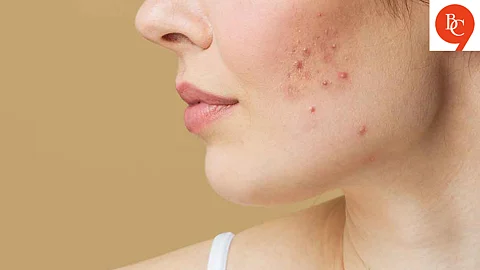

If you find yourself battling recurring pimples, especially around your chin and jawline, chances are you’re dealing with hormonal acne.
Let’s break down what hormonal acne actually is, why it happens, and how you can manage it naturally — without harsh chemicals or expensive treatments.
What is Hormonal Acne?
Hormonal acne is exactly what it sounds like — acne triggered or worsened by fluctuations in your hormones. It typically appears in women during:
Puberty
Menstruation
Pregnancy
Postpartum
Perimenopause
Discontinuing birth control
It usually shows up as deep, cystic breakouts along the chin, jawline, and cheeks, and often returns around the same time each month, especially before your period.
What Causes Hormonal Acne?
Hormonal acne is driven by:
Excess androgen production: Androgens (like testosterone) increase oil (sebum) production in your skin, clogging pores.
Insulin resistance or PCOS: These conditions can cause hormonal imbalances.
Stress: High cortisol levels throw off your hormonal rhythm.
Poor diet or gut health: Inflammatory foods and poor digestion can affect hormone levels.
Unlike surface-level acne, hormonal acne forms deep under the skin and may not come to a head. It’s often painful, slow to heal, and leaves behind stubborn scars.
Natural Ways to Manage Hormonal Acne
While medical treatments (like birth control pills or spironolactone) are available, many prefer to start with natural methods. Here’s how you can deal with hormonal acne the holistic way:
1. Balance Your Diet
Your skin reflects what you eat. Choose foods that support hormone balance:
Include:
Leafy greens (spinach, kale)
Omega-3 rich foods (flax seeds, walnuts, fatty fish)
Probiotics (yogurt, kimchi, kombucha)
Fiber-rich fruits & veggies
Avoid:
Dairy (linked to acne in many cases)
Sugar and refined carbs (spike insulin, worsen acne)
Processed junk food
Excess caffeine
2. Support Liver & Gut Health
Your liver helps break down excess hormones, and your gut eliminates them.
Start your day with warm lemon water
Add milk thistle or dandelion tea to your routine
Consume fermented foods to improve gut flora
Drink enough water (at least 2–3 litres a day)
3. Adopt a Gentle Skincare Routine
Don’t overload your skin with harsh actives. Instead:
Use non-comedogenic, fragrance-free cleansers
Try natural anti-inflammatory ingredients like tea tree oil or aloe vera
Use a clay mask (like bentonite or multani mitti) once a week
Gently exfoliate with AHA/BHA once or twice a week (if your skin tolerates it)
4. Track Your Cycle and Symptoms
Use a period tracker app to note when breakouts appear. This can help identify hormonal patterns and make lifestyle adjustments around your cycle.
5. Consider Natural Supplements
Always consult a doctor before starting supplements, but some that may help include:
Zinc (anti-inflammatory and reduces oil production)
Vitamin B6 (helps with PMS and hormone metabolism)
Evening Primrose Oil (may balance hormones naturally)
Spearmint Tea (shown to reduce testosterone levels)
6. Reduce Stress
Chronic stress leads to elevated cortisol, which throws your hormones out of sync.
Practice mindful breathing or meditation daily
Try yoga, especially hormone-balancing poses like child’s pose and butterfly stretch
Prioritize sleep (7–8 hours) — hormonal repair happens at night
7. Limit Toxin Exposure
Endocrine-disrupting chemicals in your environment can mess with your hormones.
Switch to natural skincare & makeup
Avoid plastic containers (especially for hot food)
Choose organic sanitary pads or menstrual cups
Filter your water if possible
When to See a Doctor
Natural remedies take time, but if your acne is severe, painful, or impacting your self-esteem, it’s worth seeing a dermatologist or endocrinologist. They can test your hormone levels and rule out conditions like PCOS or thyroid disorders.
Hormonal acne is more than skin deep — it’s a sign that your body’s internal balance is off. While treating it naturally requires consistency and patience, it empowers you to work with your body instead of just masking symptoms.
